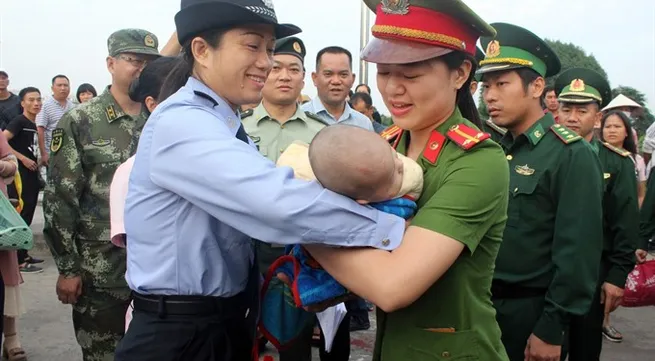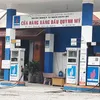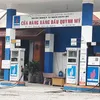Human trafficking on the rise in Việt Nam


|
| A policewoman of Móng Cái City’s Police Department (right) receives a baby – a victim of human trafficking, from a policewoman of China’s Fangchenggang City on Tuesday.— VNA/VNS Photo Nguyễn Hoàng |
HÀ NỘI — Human trafficking in Việt Nam was on the increase because it was difficult to control, according to experts. They said the crime especially targeted women and children.
The manager of a hotline to prevent human trafficking prevention, Nguyễn Thuận Hải, from the Department of Child Care and Protection, said that more information related to the issue was now available.
The hotline received 1,250 calls in 2014. Last year, the number tripled. This year the number showed no sign of falling. More than 50 per cent of the calls are about child trafficking.
Statistics from the Police General’s Department show that from 2011 until now, the country reported nearly 3,000 cases of human trafficking involving nearly 6,000 victims. The problem is more serious in provinces close to the border.
From 2012-17, more than 600 victims of trafficking returned to Lào Cai Province in the northern mountains. Many of them were not locals.
Quảng Ninh Province received nearly 200 victims, while central Thừa Thiên-Huế Province received about 250.
During a conference on implementing an ASEAN convention on preventing human trafficking held by the Agency of Social Evil Prevention, experts warned that human traffickers had complicated and dangerous tricks.
They had an honest appearance and focused on children, students with little experiences and social skills, or women and men living in poverty. They also pretended to take people for work, tourism or getting married - and then sold them.
Vietnamese agencies have conducted several measures to prevent trafficking. The Law on Human Trafficking Prevention and Control was implemented in 2011.
Việt Nam sets aside every July 30 as the national day against traffickers. The country has also implemented international conventions about crimes prevention, including the ASEAN Convention Against Trafficking in Persons, Especially Women and Children.
Hà Nội authorities assign districts to control policies related to human trafficking. Many communes have set up models on preventing trafficking.
In provinces with serious trafficking problems, such as Lào Cai, Nghệ An, Quảng Ninh and Tây Ninh, the labour, invalids and social affairs sector organise training courses against traffickers. Lào Cai Social Evils Prevention Department said most victims returned with physical and mental problems.
Some of them developed mental problems or had small children. Others were of unclear origin so it was difficult for localities to give them support, said Long.
Provincial authorities often took victims to social sponsoring centresd for vocational training and health checks. However, due to a shortage of funds, few victims can re-integrate into the community, he said.
Long proposed that organisations raise community awareness and join hands in supporting the victims.
“Lào Cai has done this and initially, the move has been successful,” said Long. — VNS
Tags:





